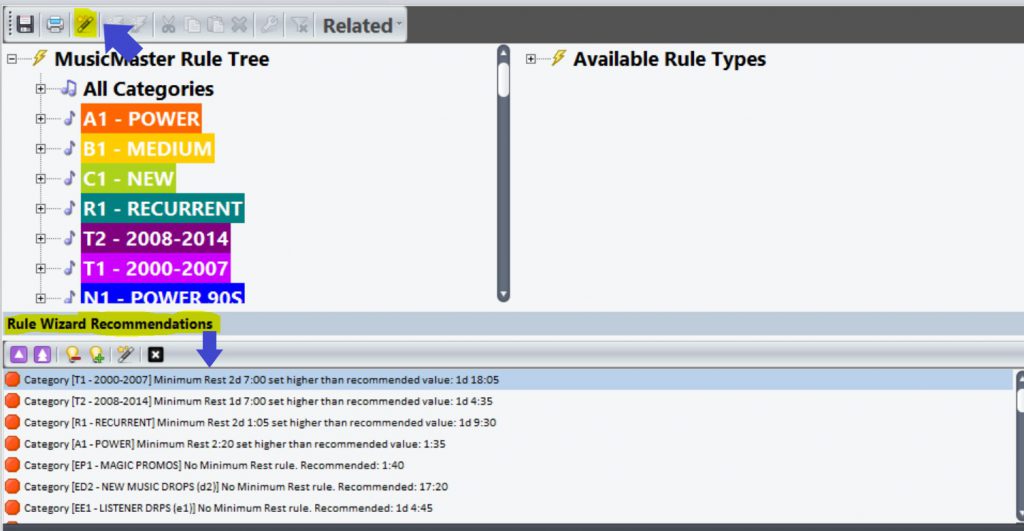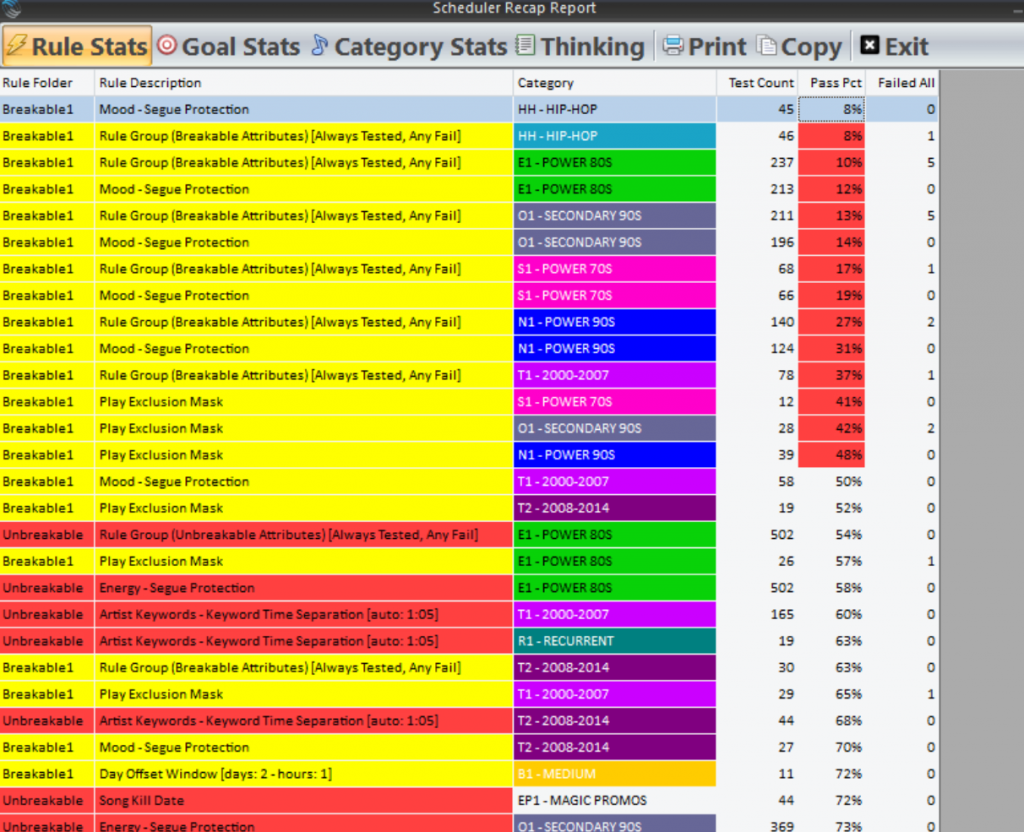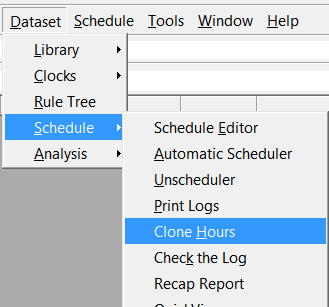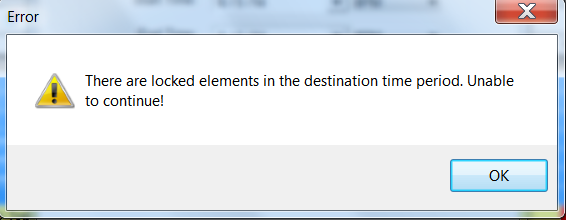MusicMaster Blog
Rule Group Scheduling Trick for Near Perfect Logs posted on June 18th, 2024
by Jesus Rodriguez
In my previous life before MusicMaster, I was tasked with scheduling up to eight radio stations that were under my watch in one day. As you can imagine, that can take hours to do, especially if you have some strict rules and unscheduled positions. In this brief blog, I will share one of my favorite tricks to get the job of scheduling done quickly and accurately by using two different rule group setups. When you walk away from this, I hope you tell yourself, “Why didn’t I think of that, genius!”
I first created two rule groups, one for the Automatic Scheduler and the other for the Schedule Editor. Let’s begin with the first one, the Automatic Scheduler rule group.

Place this group in your Unbreakable section of the All-Category folder at the top of the Rule Tree. You can name it anything you like, as the name is not essential. Just make sure it’s something you can easily remember. The key settings here are the ‘Availability’ dropdown, which should be set to ‘Rules are only available in the Automatic Scheduler’ and the ‘Group Mode’ in the upper right, which should be set to ‘Test rules as if they are not in a rule group.’
In this Rule Group, place all your most restrictive rules that would be perfect in a perfect world. If you had enough music, genres, artists, tempo, etc., this rule would create your perfect radio station for the entire day. However, yes, I am hearing you. “Wouldn’t this create some unscheduled positions?” Yes, so now let’s move on to the second Rule Group.

Like the first Rule Group, you can give it any description you like. The name does not matter. Make it something familiar to you. The most critical parts are the dropdown under ‘Availability’ set to ‘Rules are only available in the Schedule Editor’. Also, like with the first, put your Group Mode on the upper right to ‘Test rules as if they are not in a rule group’.
Copy the rules from the first Rule Group and paste them into the second one. You can place this group in your Unbreakable or Breakable folder in the all-category section. I personally like mine in my Breakable section for this group. Now, go through your rules, and relax those you usually break when manually filling in unscheduled positions. For instance, if your rule is set to not play more than two rock songs in a row, but you occasionally allow three in a row to fill in the unscheduled position, set it up that way here. This way, the next step does it for you, eliminating the need for manual adjustments. This applies to any other rules you tend to look past or relax in your decision-making when you have to fill unscheduled positions. Think of what is ok and not that big of a deal for your station’s listening experience; hits are hits!
Now that these two Rule Groups are ready, run your Automatic Scheduler by going to Dataset, Schedule, and Automatic Scheduler. You will end up with unscheduled positions because of the stricter rules of your perfect radio station scenario in Rule Group One. When the Schedule Editor is opened after your Automatic Scheduling is complete, hide everything but your unscheduled music elements from the log by going to the Show/Hide Elements tab.

This will open the following window, and you can hide these items temporarily by unselecting them.

Your log should look something like this with all your unscheduled music elements. To turn all those positions blue, click on the top left corner box, as shown in the image below.

Are you ready for the magic? Press Shift + F9. This will now fill in all of your unscheduled positions with the more relaxed rule settings you created the same way you would select your songs manually for unscheduled positions, should you decide to break your rules.
Now, I will get my occasional third rock song in a row, which is not the end of the world for me, and any other rules I felt were worth relaxing. On the plus side, I only have a handful of unscheduled songs, an almost 100% perfect log based on my ideal radio station rules. It also allows for filling in unscheduled positions in seconds rather than taking much longer to go through each position.

I highly recommend restoring all the hidden elements and reviewing your log for any adjustments you may want to make.

This trick is helpful and saves time while getting you closer to a perfect log in minutes. If you need any assistance, please contact your support representative at MusicMaster.
“Who Did That?” Tracking Schedule Editor Changes posted on September 15th, 2023
by Paul Ziino
Looking at the Schedule Editor, have you ever wondered “Who did that?” Here is a quick and easy way to find out.
First, you need to make sure that Dataset Security is turned on under Tools/Options/Dataset Security (as well as Users and Rights). This means each user will have a unique username and password for logging into the database. Once that is done, you can see who has made changes and when within the schedule editor.
There are three fields you’ll want to add to your Schedule Editor view: Schedule:Manual, Schedule:Changed By, and Schedule:Last Change.

Now that your fields have been added to the view, you can see that Schedule:Changed By will tell us who made the last edit in the hour. Schedule:Last Change tells us when that edit was made. In the Schedule:Manual field, you will see a capital M on any position that was edited (not scheduled by the automatic scheduler).
You need to display Hour Headers via the Show/Hide Elements icon in order to see the Changed By and Last Change field information.

Here we see Tom made the last changes at 3:28pm.

In the next picture, we see that Cindy made the most recent changes to the hour.

There’s also a handy feature to see what changes were made between the time you exported your log vs. the time your log was reconciled. You can do so with the History Snapshot.
At any time in the Schedule Editor, you are able to create a snapshot of the log by clicking the camera icon to Compare current history to a saved snapshot.

The first time you click the icon in a schedule you’ll create that snapshot. You can also set MusicMaster to automatically create a snapshot upon export.

Once the snapshot is created, you can compare it to the log as it stands by clicking that camera icon in the schedule editor again. Then click Compare. Your display will allow you to Show All, Show Changed items, or Show Unchanged items. Here’s a sample of the Changed Items. Note, hours with no changes will just display hour headers in this view.

Need a hand setting any of this up? Make sure to contact your MusicMaster Support Consultant. They have the answers you seek!
Customizing Your Results Bar posted on March 9th, 2023
by Paul Ziino
The Results Bar in your Schedule Editor can be set up to show a variety of information about the active song in the log. Today we review the various options.
To turn on the Results Bar, click the pulldown on the right side of the wrench icon (Toggle Toolbars) then check “Results Bar.”

The first time you turn on the Results Bar it may be empty, or it may populate with a few items right away. Either way, you can customize it by right-clicking within and selecting Customize. You will be presented with a Customize Results Bar window that looks like this.

You will see available panels for any Keyword field’s Separation and Nearest Plays, Current Date and Hour Displays, Hour Rotation Map, Multi-Station Separation, Nearest Play Yesterday/Same Hour/Same Shift, Shift Hour Rotation, Shift Rotation Map, Song Segue Nearest Plays and Separation, Song Failure Alerts, as well as Song Nearest Plays/Rotation and Separation. Following is a breakdown of each and what they mean.
Current Date Display and Current Hour Display

This tells you where your cursor is, on the date and hour.
Hour Rotation, Shift Hour Rotation, and Shift Rotation

Hour Rotation shows the song plays leading up to the play where your cursor sits.
Shift Hour Rotation shows the plays of this song within the same shift and indicates what shift that is.
Shift Rotation shows the shift sequence in which the current song has played, with dashes on either side of the current play selected.
Song Segue Nearest Plays and Song Segue Separation

Both these panels tell you similar information. Note that the segues are looking at the song where the cursor resides and the song that played before it. Song Segue: Nearest Plays looks back and ahead to when these two songs last played together (in either order), and when they will play together next (in either order). Song Segue: Separation displays this same info, but as a total of Days/Hours/Minutes.
Song Fail Alert, Nearest Plays, Rotation, and Rest

Song Fail Alert will display in Red if the active song violates an unbreakable rule, yellow if the rule is breakable, or blank if no rules are violated.
Nearest Plays tells you the date and time when that song was last scheduled or scheduled next time.
Song Rotation is a mini snapshot of the last 8 days of a song’s play history.
Song Rest tells you the amount of time back and ahead of a song’s play history.
Keyword Nearest Plays and Separation

Keyword Nearest Plays will show you the last/next time a keyword is scheduled.
Keyword Separation will show you the amount of time back and ahead that keyword is scheduled.
You will have a Nearest Plays and a Separation panel available for each keyword field in your database.
Favorites?
Of course I have my favorites—the panels I like to have in my display include Current Hour, Nearest Plays in Same hour and shift, Artist Keywords Separation, Song Separation, and Song Rotation.

Try the different panels out to figure out which work best for you and your station!
Music Scheduling Therapy posted on June 28th, 2021
Music Scheduling Therapy
By Chris Malone
If you have had the privilege of sitting in a therapy session, you are aware of the benefits of having someone look at your life’s configuration and help recommend ways to get back on track. Did you know in MusicMaster, you have a built-in music scheduling therapist at your disposal too? One of the overlooked features in your Rule Tree is the Rule Wizard that gives you a list of recommendations to make to your rule tree based upon your last scheduling session.
This feature helps determine rotations miscalculations and rules that may be off-base due to the lack of available inventory in your actively scheduled music and non-music categories. The Rule Wizard can pinpoint problems with rest settings, hour rotation rules, and indicate how your attribute rules affected the scheduling session. If you notice an abundance of unscheduled positions in your most recent scheduling session, you may want to review this list and see what your MusicMaster therapist recommends.
 Additionally, you can benefit from learning how to read your scheduler recap report (Dataset, Schedule, Recap Report). In this recap report, you can sort the pass percentage column by descending order, which shows me the rules that had lowest percentage of songs that pass any given active rule (both breakable and unbreakable). Watch out for unbreakable rules that have a low pass percentage, it indicates problems with that category’s ability to tolerate the current rule setup. Remember, this is a picture of the last scheduling session. You may wish to make some notes over the course of a week before making any changes to rules or other settings.
Additionally, you can benefit from learning how to read your scheduler recap report (Dataset, Schedule, Recap Report). In this recap report, you can sort the pass percentage column by descending order, which shows me the rules that had lowest percentage of songs that pass any given active rule (both breakable and unbreakable). Watch out for unbreakable rules that have a low pass percentage, it indicates problems with that category’s ability to tolerate the current rule setup. Remember, this is a picture of the last scheduling session. You may wish to make some notes over the course of a week before making any changes to rules or other settings. 
(For even more info on the Scheduler Recap report, check out this other blog article on the topic.)
You can lean on your built-in MusicMaster scheduling therapist or you can call your MusicMaster Scheduling Consultant, have a seat on the couch and tell us your problems.
How to Clone Hours in a Log (Version 7 & Later) posted on June 17th, 2019
By Jesus Rodriguez
This blog on how to clone a log is for MusicMaster Verison 7 and later. If you are not currently using version 7, we invite you to go to help and check for update or contact a MusicMaster Scheduling Consultant for information on how to upgrade. However, have no fear if, for some reason out of your control you are not allowed to upgrade to version 7 by your superiors, you can still clone your logs. I must admit it just takes a few more steps to accomplish. If you are using an older version of MusicMaster, here is a blog article on how to clone.
You can easily clone a log or portion of a log by using the menu to access this option (DATASET-SCHEDULE-CLONE HOURS):
You then will select the start and end hour to copy from, and the start hour to copy to.
One side note, if there are any locked elements in the copy from or to part of this operation, the process will not continue and will indicate:
If you haven’t upgraded to version 7.0 the following may convince you to do so. Why you ask? Well thanks for asking, we have added some additional options as show in the image below.

Now in Version 7 and above there are almost endless possibilities of combinations of what you can clone or not clone. The first option is obvious and what it was since the feature was created to replace the hours with an exact copy of the hours you are cloning. Here comes the cool part: the ability to only clone specific items. Let’s say you replay a countdown show as an example that airs on Saturday morning and it airs again on Sunday afternoon. Well now you can select to only copy the Music Library Elements over should you have a different on-air personality hosting the second airing. This allows you to schedule the non-music elements on the second log specific to the second jocks needs.
The second and third options for only cloning non music and break note elements. How would that be useful? Well, what if you have a show that is voice tracked that also airs on multiple days but maybe you don’t want the same music airing around those cuts. Now you can clone just the break note, non-music library elements, or both to the rebroadcasted hours then schedule a different set of music around them. This is great for talk shows that you may rebroadcast but may want to use different bumper music than what you scheduled for the first broadcast.
Yes, that’s not all there’s more! With the two final options you can also append extra elements to the end of the hour and remove extra elements from the end of the target hour.
With these variations, you have the tools to copy your log exactly as needed.
Please call your Music Scheduling Consultant if you have any questions.
How to Clone Hours in a Log posted on August 18th, 2014
By Aaron Taylor
If you’re using MusicMaster Version 5.0 or later, you have the ability to clone portions of a scheduled log into another part of the day or other days entirely. This allows you very easily to reuse already scheduled content with very little effort, perhaps a countdown show, or a special feature or hours that might be time consuming to recreate “by hand”.
Fail Alerts! posted on July 7th, 2014
By Drew Bennett
MusicMaster continues to listen to our users and add new features to our products. With the release of MusicMaster Pro 5.0sr13, you will now find a new feature called Fail Alerts. (more…)
Direct Field Entry While Editing Logs posted on July 29th, 2013
By Paul Ziino
Sometimes you just know what you want to play, but scrolling through the replacement song list seems like such a waste of time. At MusicMaster we value your time, so we have many ways to speed up this process. (more…)
Looking for Unscheduled Positions and the Manual-Assist Scheduler posted on April 22nd, 2013
by Paul Ziino
After you’ve run the Automatic Scheduler, many programmers will look for the unscheduled positions in their log—positions the Auto-Scheduler was unable to fill due to unbreakable rule violations, lack of options, or manual clock positions. There are several ways to do this. (more…)
5 Ways to Decrease Your TSE (Time Spent Editing) posted on September 3rd, 2012
By Marianne Burkett
While there are some who love editing logs for hours on end, most of my clients don’t have the time to check every history or segue for each song in a given day. Here are a few things to help you shave some time off of editing the logs without sacrificing your personal editing style! (more…)



